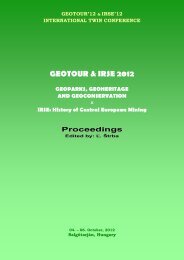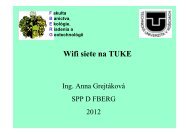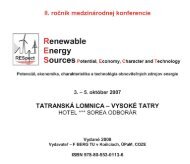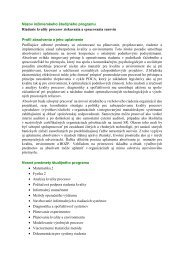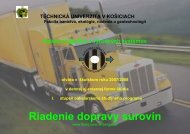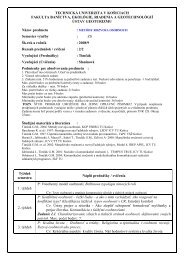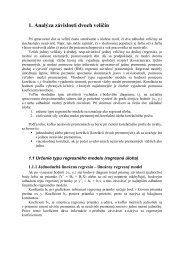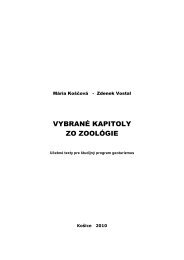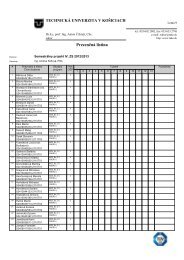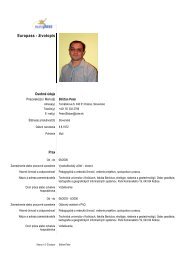GEOTOUR & IRSE 2012.pdf - Fakulta BERG - TUKE
GEOTOUR & IRSE 2012.pdf - Fakulta BERG - TUKE
GEOTOUR & IRSE 2012.pdf - Fakulta BERG - TUKE
Create successful ePaper yourself
Turn your PDF publications into a flip-book with our unique Google optimized e-Paper software.
<strong>GEOTOUR</strong> & <strong>IRSE</strong> 2012<br />
Because of the fact that the historical monuments regarded as sites of historic and cultural<br />
importance belong to non-renewable resources, their management must base on the long-term<br />
prospect. It is also discernible that historical monuments and other places which form the<br />
cultural heritage serve many people as sources of emotional and aesthetic experience and the<br />
modern society may benefit from the protection and active use of the mentioned cultural<br />
heritage.<br />
Former mines constitute an integral part of archaeological heritage and testify the past mining<br />
activities. The underground objects contain relics of mine working techniques used in the<br />
past, pieces of equipment and housings (made of metal as well as wood). In the mine<br />
surroundings are usually located the former mineral processing plants, smelting infrastructure<br />
and social buildings.<br />
The chain of underground mine workings normally develops according to geological structure<br />
of the deposit (gathers, down- and upcasts, dens, seams), often transecting the encountered<br />
geological formations. That enables the recognition of the occurring mineralization zones.<br />
The exploited ore-bodies, with no useful components still contain vestigial amounts of<br />
minerals. That helps in determining the basic structure and mineralization zones for the<br />
former exploitation.<br />
The local societies‟ activity linked to the excavation works, processing and smelting deeply<br />
interferes in the landscape of mining regions and highly influences their economic<br />
development. The essence of the matter can be observed while analysing the archival<br />
documentations, the rich iconography, but also the changes in architecture, household<br />
furnishing, in nomenclature and cultural traditions. Finally after suspending mineral<br />
exploitation also nature claims its rights and the dormant mines often serve as shelters for<br />
fauna and flora (vegetation, mouldings, insects, spiders, rodents). In general we can state that<br />
old mines constitute a significant element of cultural heritage, often quite foreign for the<br />
society and for environment defendants.<br />
Mining sites as elements of cultural heritage, like the forgotten former mining pits, mine<br />
waste dumps or ruined buildings and mining facilities form a tangible testimony of the long,<br />
even a few hundred years old history of economic development of the region. They testify the<br />
comprehensive knowledge and skills of miners from ancient times who, although vested with<br />
simple means (compared to the contemporary ones), since the early medieval period were<br />
able to excavate the riches of the earth. Large amount of relics of the former mining in Lower<br />
Silesia, their undeniable historic and cognitive value, as well as lack of studies on their<br />
present state of preservation, result in necessity of bringing into force the efforts on their<br />
precise cataloguing and documentation.<br />
Making an effort for protection of the former mining sites is necessary not only for their<br />
historic value, but also for their proper preservation, in order to eliminate the threat posed in<br />
some cases by them, especially towards people and animals. Still the activities adequate for<br />
their preservation, monitoring and protection of the dormant mine workings accessible for<br />
tourists in form of underground trails, like in Złoty Stok, Złotoryja, Kletno and Kowary in the<br />
Owl Mountains and Jizera Mountains, are necessary for proper administration with mining<br />
sites regarded as elements of cultural heritage and for disseminating knowledge about them.<br />
Apart from the mentioned good examples of protecting the former Lower Silesian mining<br />
heritage, problems occur by the complex and adequate preservation and making accessible the<br />
two mining basins put out of action by the end of the last century and located in vast areas,<br />
interesting in their geo-variety, i.e. the Old Copper Basin in the North Sudetes‟ Trough and<br />
the Hard Coal Basin in the Middle Sudetes‟ Trough.<br />
FUNDAMENTALS OF THE LOCAL DEVELOPMENT<br />
Local development is a broad concept, which assumes that all changes, including<br />
economical, are driven by ideas and social power. For purpose of this context, the most<br />
121



